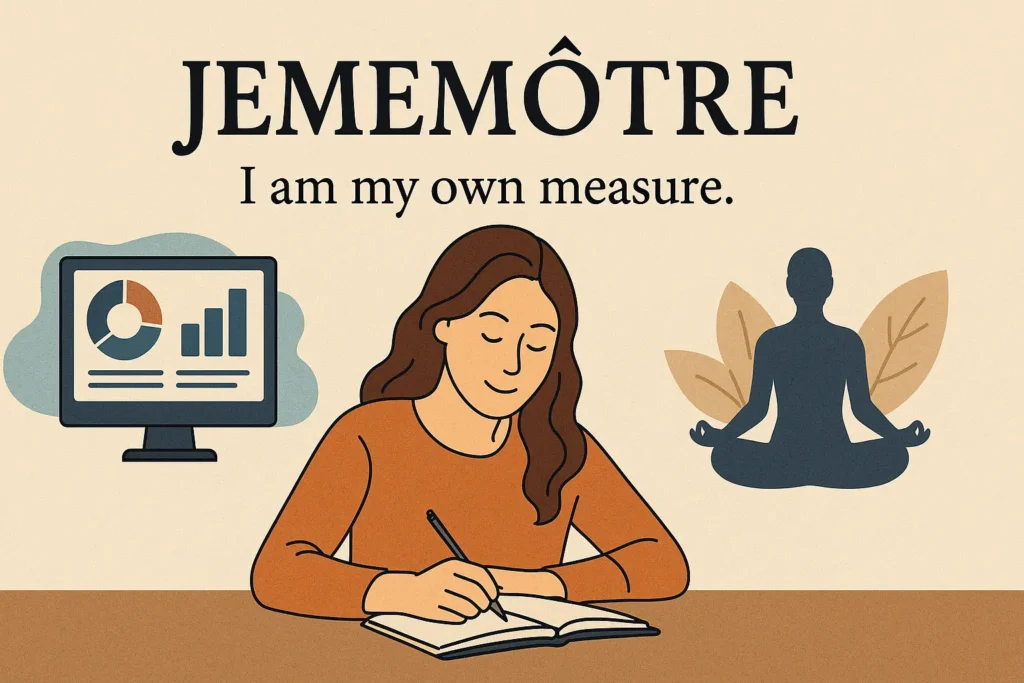Have you ever stumbled on a word that immediately caught your curiosity? That’s exactly what happens when people first hear jememôtre. It looks unusual, feels exotic on the tongue, and makes you wonder what meaning hides behind it. Is it a trendy brand name, an artistic movement, or something far older and deeper? Let’s dive into this fascinating term and explore why it has been popping up in creative and cultural conversations lately.
The Mysterious Origins of Jememôtre
Every word has a story. Jememôtre is no exception. Linguists and language enthusiasts often debate its roots because it doesn’t directly match common words in major European languages. Some trace its sound to French origins—the accent on the “ô” certainly gives it a French flavor. They suggest it could be a playful hybrid of “je me montre,” which roughly translates to “I show myself” or “I reveal myself.” Over time, artists and writers might have stylized it into jememôtre to make it stand out.
Others argue the term gained momentum through online communities that love coining new words to describe emotions or cultural moments that existing vocabulary cannot capture. On forums and niche blogs, jememôtre began to take on a life of its own. People used it to describe that tender, almost nostalgic moment of self-expression when you reveal your inner world to others without fear.
A Word That Bridges Language and Culture
Language is alive. It grows, transforms, and travels across borders. Jememôtre does exactly that. It acts as a bridge between cultures and generations. Younger creators on social media embraced the term as a badge of authenticity. Meanwhile, older language purists admired its clever nod to classical French structure. This blend makes jememôtre a perfect example of how digital culture keeps language evolving.
Furthermore, the term sparks conversations about identity. In an age where people constantly present curated versions of themselves online, jememôtre suggests a return to genuine self-presentation. It’s not about polished perfection but about showing the messy, beautiful reality of being human.
How Jememôtre Became a Creative Movement
In recent years, jememôtre has moved beyond being just a quirky word. It has inspired visual artists, musicians, writers, and designers. Indie bands have named albums after it. Graphic designers have created minimalist logos using the word’s elegant accents. Even fashion labels have printed jememôtre on shirts and tote bags as a subtle reminder to embrace self-expression.
Part of its rise comes from social media challenges. On platforms like Instagram and TikTok, people post short videos or photos labeled #Jememôtre. These clips often show a personal transformation—someone painting their first canvas, trying a new hairstyle, or sharing a poem they’ve hidden for years. The hashtag encourages openness and bravery, which resonates strongly with today’s audiences.
Jememôtre in Art and Design
Art galleries in cities like Paris, Montreal, and Berlin have featured jememôtre-themed exhibitions. One memorable show invited participants to stand in front of a mirror and write a single word describing themselves on a transparent panel. The resulting collage of self-descriptions created a powerful visual representation of collective identity. Curators explained that jememôtre captured the spirit of the exhibition: a gentle revealing of one’s inner voice.
In graphic design, jememôtre has a striking visual balance. The accented “ô” acts as a focal point. Designers love experimenting with typefaces to highlight its unique shape. You might see jememôtre on posters, album covers, or even in small branding projects where the goal is to evoke emotion and curiosity.
The Emotional Resonance of Jememôtre
Why does jememôtre resonate so deeply with people? The answer lies in its emotional undertone. At a time when many feel pressured to fit molds or chase trends, the word suggests a softer alternative: just reveal yourself. It tells you to show your true colors even if they’re imperfect. This emotional quality makes it powerful in storytelling, music, and visual narratives.
Writers use jememôtre to describe moments of vulnerability. A character might experience jememôtre when they finally admit their feelings to a friend. Musicians write lyrics about finding the courage to sing their own song—literally and figuratively. Even in casual conversation, saying “That was such a jememôtre moment” can convey warmth and understanding without needing lengthy explanations.

Social Media’s Role in Popularizing Jememôtre
The internet thrives on novel and evocative words. Jememôtre found fertile ground on platforms where brevity meets emotion. Influencers began using it to title posts about personal growth, creativity, and authenticity. Soon, it became a trend. Brands noticed and adopted the term to market products that promised genuine self-expression—whether a handcrafted journal, a new photography app, or a sustainable clothing line.
Social media’s global reach helped jememôtre cross language barriers. Non-French speakers embraced it without worrying about perfect pronunciation. In fact, playful mispronunciations became part of its charm. Videos comparing different accents attempting jememôtre gathered millions of views, further cementing its place in online culture.
Jememôtre in Everyday Life
Beyond the arts and the internet, jememôtre has crept into daily language. Friends might use it jokingly after sharing a personal story. Teachers might encourage students to “have a jememôtre moment” when presenting their projects. Therapists and coaches even borrow the word to discuss the importance of authenticity in self-development.
This casual adoption shows how deeply people connect with the concept. Jememôtre isn’t reserved for high culture or academic debate. It’s a living, breathing idea that people carry into coffee shop conversations, book clubs, and late-night chats.
How Businesses Are Adopting Jememôtre
Modern brands know that consumers value transparency and sincerity. Companies looking to build trust are drawn to words like jememôtre that evoke openness. Small boutique shops might use it in slogans to signal handcrafted quality. Large corporations might subtly reference it in marketing campaigns about authenticity.
However, the commercial use of jememôtre sparks debate. Some critics worry that turning a heartfelt concept into a marketing buzzword risks diluting its meaning. Supporters argue that widespread use spreads the positive message further. Either way, the conversation around jememôtre continues to evolve.
Jememôtre as a Personal Practice
At its core, jememôtre isn’t just a word or a trend—it’s a practice. To live jememôtre means to embrace vulnerability and share your genuine self with others. This could be as simple as posting an unfiltered photo or as profound as opening up to a loved one about your dreams and fears.
People who adopt jememôtre as a practice often describe feeling lighter and more connected. By shedding the masks they’ve worn for years, they discover deeper relationships and a stronger sense of self. The word becomes a quiet reminder that authenticity is not only brave but also beautiful.
Why Jememôtre Matters in Today’s World
In a world filled with curated feeds, staged photos, and polished press releases, authenticity can feel rare. Jememôtre offers a refreshing counterbalance. It reminds us that showing up as ourselves has power. This idea resonates across cultures, generations, and professions.
Furthermore, jememôtre reflects broader social trends toward mental health awareness and emotional intelligence. People are increasingly valuing transparency in friendships, workplaces, and leadership. Jememôtre captures this shift in a single elegant term.
Examples of Jememôtre Moments Around Us
Think of a street performer who sings without worrying about perfection. That’s a jememôtre moment. Consider a colleague who admits they don’t know the answer in a meeting but expresses a willingness to learn—that’s jememôtre too. Even a child handing you a scribbled drawing with pride is offering jememôtre.
These small moments build community and trust. They show that revealing ourselves can inspire others to do the same. Jememôtre moments are everywhere once you start looking for them.
Jememôtre in Global Perspectives
Though its roots may hint at French, jememôtre’s spirit is universal. In Japan, people compare it to “honne,” the true feelings behind one’s outward behavior. In South Africa, some liken it to “ubuntu,” the belief in shared humanity. In Latin America, it echoes “sinceridad” and “autenticidad.” These parallels show that cultures worldwide value genuine self-expression.
This universality also explains why jememôtre has gained traction in international creative circles. It gives a name to something many cultures already understand but perhaps didn’t have a single word for.
The Future of Jememôtre
Language trends can be unpredictable. Some fade quickly, while others become permanent fixtures. Jememôtre’s combination of emotional resonance, visual beauty, and cultural relevance suggests it may stick around for years. As more artists, educators, and storytellers adopt it, the word could even find its way into dictionaries or academic studies on digital culture and modern linguistics.
Future generations might look back and see jememôtre as part of a larger movement toward authenticity in the early twenty-first century. Whether it remains trendy or becomes timeless, its influence has already left a mark.
How to Embrace Jememôtre Yourself
You don’t need a public platform or artistic talent to practice jememôtre. Start small. Write a personal letter to a friend and share a feeling you’ve been holding back. Post a photo that reflects your reality instead of perfection. Compliment someone sincerely without worrying about how it sounds. Each action, however small, contributes to a culture of openness.
Over time, these small acts can transform relationships and self-perception. By living jememôtre, you join a global community of people choosing honesty over façade.
A Word That Connects Us All
Ultimately, jememôtre is more than letters on a page. It’s an invitation. It invites you to step into the world as you are, to reveal your heart without fear, and to appreciate the raw beauty of others doing the same. It connects strangers across continents, artists across mediums, and friends across life’s ups and downs.
So, the next time you hesitate to speak up, to share a story, or to create something new, remember jememôtre. Let it be your gentle nudge toward authenticity. In a noisy world of curated images and polished messages, your unfiltered truth might be the most powerful thing you have to offer.


